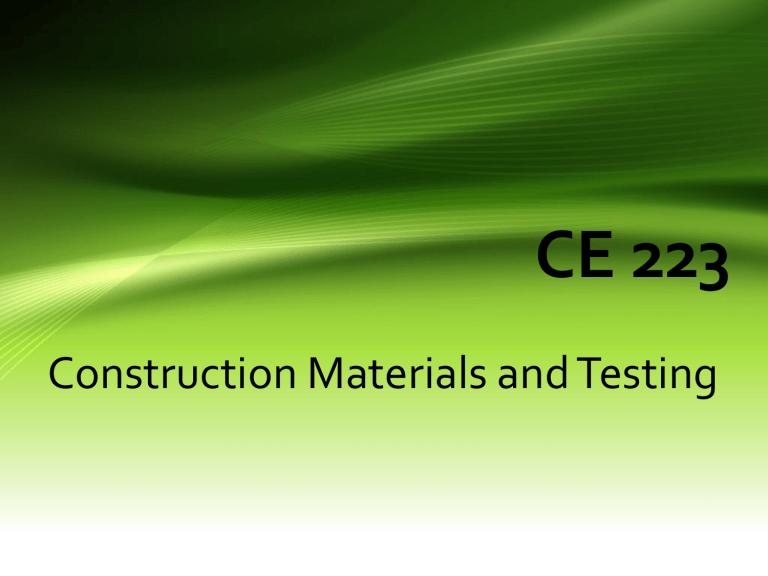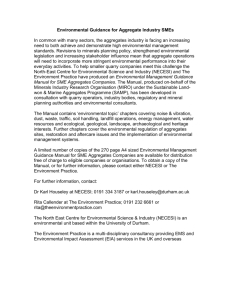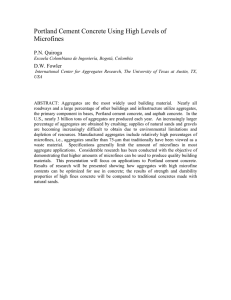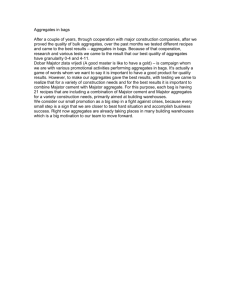
CE 223 Construction Materials and Testing Topic 2: AGGREGATES Topic outline: § Uses of Aggregates § Sources § Types of Aggregates CE 223 Construction Materials and Testing_Aggregates Intended Learning Outcomes After completing this course, the student must be able to: • Identify types of aggregates. • Explain the use of aggregates and its properties. CE 223 Construction Materials and Testing_Aggregates AGGREGATES Aggregates means a mass of crushed stone, gravel, sand, etc, predominantly composed of individual particles. CE 223 Construction Materials and Testing_Aggregates The 3 main uses of Aggregates in civil engineering 1. As a Load Bearing Material § an underlying material for foundations and pavements § used to resist the overall (static as well as dynamic) load, § to distribute the load properly to the supporting ground § and to drain the water off the surface CE 223 Construction Materials and Testing_Aggregates The 3 main uses of Aggregates in civil engineering 2. As a Filling Material § used for economy, § reduce shrinkage and cracks § and to strengthen the structure § used as riprap for erosion protection CE 223 Construction Materials and Testing_Aggregates The 3 main uses of Aggregates in civil engineering 3. As an Infiltrating Material § used in water filtration § and sewage treatment processes § ingredients in portland cement and asphalt concretes. CE 223 Construction Materials and Testing_Aggregates Uses of Aggregate in Portland Cement Concrete Ø Increases the volume of concrete, thus reduces the cost. Aggregates account for 6075% of the volume of concrete and 79-85% weight of PCC. Ø To provide a rigid structure. Ø To reduce the shrinkage and cracking. Ø Concrete aggregate is used in many structures and substructures e.g. different elements of a Building, bridges, foundations. CE 223 Construction Materials and Testing_Aggregates Uses of Aggregate in Portland Cement Concrete Ø The smaller the aggregate size the greater its surface area and the more binding material (cement) will be required, resulting in a higher cost. Ø The greater the aggregate size the larger will be the voids, resulting in wastage of binding material (cement). Ø Hence a mixture of coarse and fine aggregate is used in concrete to avoid both these problems. CE 223 Construction Materials and Testing_Aggregates Uses of Aggregate in Asphalt Concrete • Aggregates constitute 75% to 85% of the volume and 92% to 96% of the mass. The asphalt cement acts as a binder to hold the aggregates together, but does not have enough strength to lock the aggregate particles into position. • As a result, the strength and stability of asphalt concrete depends mostly on interparticle friction between the aggregates and, to a limited extent, on the binder. CE 223 Construction Materials and Testing_Aggregates General size characteristics of aggregates Fine aggregates • Sand and/or crushed stone • < 4.75 mm sieve (No. 4). Coarse aggregates • Gravel and crushed stone • > 4.75 mm sieve (No. 4). A 4.75 mm sieve has openings equal to 4.75 mm between the sieve wires. A No. 4 sieve has four openings CE 223 Construction Materials and Testing_Aggregates per linear inch. Sources 1.Natural sources for aggregates include gravel pits, river run deposits, and rock quarries. Gravel comes from pits and river deposits Crushed stones result of processing rocks from quarries. Usually, gravel deposits must also be crushed to obtain the needed size distribution, shape, and texture 2.Manufactured aggregates can use slag waste from iron and steel mills and expanded shale and clays to produce lightweight aggregates. Heavyweight concrete, used for radiation shields, can use steel slag and bearings for the aggregate. Lightweight concrete used for insulation. e.i Styrofoam beads as aggregate Natural lightweight aggregates include pumice, scoria, volcanic cinders, tuff, and diatomite. CE 223 Construction Materials and Testing_Aggregates Types of Aggregates Three General Classification 1. Geological 2. Physical 3. Chemical CE 223 Construction Materials and Testing_Aggregates 1. Geological Classification (i) Igneous Rocks: Ø These rocks are formed by cooling and solidifying of the rock masses from their molten magmatic condition of the material of the earth. Ø Generally igneous rocks are strong and durable. Ø Granite, trap and basalt are the rocks belonging to this category. Granites are formed by slow cooling of the lava under thick cover on the top. Hence they have crystalline surface. The cooling of lava at the top surface of earth results into non-crystalline and glassy texture. CE 223 Construction Materials and Testing_Aggregates 1. Geological Classification (ii) Sedimentary Rocks: Ø Due to weathering action of water, wind and frost existing rocks disintegrates. The disintegrated material is carried by wind (Aeolian) and water (Alluvial). Ø Flowing water deposits its suspended materials at some points of obstacles to its flow. These deposited layers of materials get consolidated under pressure and by heat. Chemical agents also contribute to the cementing of the deposits. Ø The rocks thus formed are more uniform, fine grained and compact in their nature. They represent a bedded or stratified structure in general. These are sand stones, lime stones, mud stones etc. CE 223 Construction Materials and Testing_Aggregates 1. Geological Classification (iii) Metamorphic Rocks: Ø Previously formed igneous and sedimentary rocks undergo changes due to metamorphic action of pressure and internal heat. Ø For example due to metamorphic action granite becomes greisses, trap and basalt change to schist and laterite, lime stone changes to marble, sand stone becomes quartzite and mud stone becomes slate. CE 223 Construction Materials and Testing_Aggregates 2. Physical Classification (i) Stratified Rocks: Ø These rocks are having layered structure. They possess planes of stratification or cleavage. Ø They can be easily split along these planes. Ø Sand stones, lime stones, slate etc. CE 223 Construction Materials and Testing_Aggregates 2. Physical Classification (ii) Unstratified Rocks: Ø These rocks are not stratified. They possess crystalline and compact grains. Ø They cannot be split in to thin slab; example Granite, trap, marble etc. CE 223 Construction Materials and Testing_Aggregates 2. Physical Classification (iii) Foliated Rocks: Ø These rocks have a tendency to split along a definite direction only. Ø The direction need not be parallel to each other as in case of stratified rocks. Ø This type of structure is very common in case of metamorphic rocks. CE 223 Construction Materials and Testing_Aggregates 3. Chemical Classification (i) Silicious rocks: Ø The main content of these rocks is silica. Ø They are hard and durable. Ø Examples of such rocks are granite, trap, sand stones etc. CE 223 Construction Materials and Testing_Aggregates 3. Chemical Classification (ii) Argillaceous rocks: ØThe main constituent of these rocks is argil i.e., clay. ØThese stones are hard and durable but they are brittle. Ø They cannot withstand shock. Slates and laterites are examples of this type of rocks. CE 223 Construction Materials and Testing_Aggregates 3. Chemical Classification (iii) Calcareous rocks: Ø The main constituent of these rocks is calcium carbonate. ØLimestone is a calcareous rock of sedimentary origin while marble is a calcareous rock of metamorphic origin. CE 223 Construction Materials and Testing_Aggregates • Aggregates should be clean and able to bond to the cement paste. If materials such as clay are stuck to the aggregate surface cement paste will not bond to the stone and the strength of the mix will be compromised. • Aggregate should not have excessive dust coatings, which can reduce the bond between cement and stones and increase water demand. • Other undesirable ingredients include pyrite, coal and sulphate. If pyrite is in aggregate it can decompose and this results in staining of the concrete surface. CE 223 Construction Materials and Testing_Aggregates • Coal and lignite may swell during the life of a structure and they sometimes decompose; this can leave voids in the concrete. • Some aggregates are susceptible to alkali aggregate reaction. These aggregates contain particular silicates which can react with the alkalis produced when cement hydrates. • Fortunately, this occurrence is rare, but when it occurs, because the reaction is expansive, the concrete can spall and crack. CE 223 Construction Materials and Testing_Aggregates REFERENCES: • https://www.aboutcivil.org/uses-of-aggregate.html • • • • • • • • • Allen, E & Iano J. (2009),Fundamentals of Building Construction Materials & Methods, 5th Edition, John Wiley & Sons, Inc., Hoboken, New Jersey Bhavikatti, S.S. (2010), Basic Civil Engineering, New Age International (P) Limited, Publishers Duggal, S.K.(2008), Building Materials, 3rd Edition, New Age International (P) Limited, Publishers Goncalves, M.C. and Margarido F. (2015), Materials for Construction and Civil Engineering Science, Processing, and Design, Springer International Publishing Switzerland Kett,I. (2000),Engineered Concrete Mix Design and Test Methods, CRC Press LLC LABTEST Material Testing Equipment Mamlouk, M.S. & ZaniewSki, J.P.(2017), Materials for Civil and Construction Engineers, 4th Edition, Pearson Merritt, F.S. & Ricketts J.T., Building Design and Construction Handbook, 6th Edition, McGraw-Hill CTTO: Pictures Prepared & Presented by: Engr. BERNADETH V. DAPUN CE 223 Construction Materials and Testing_Aggregates


